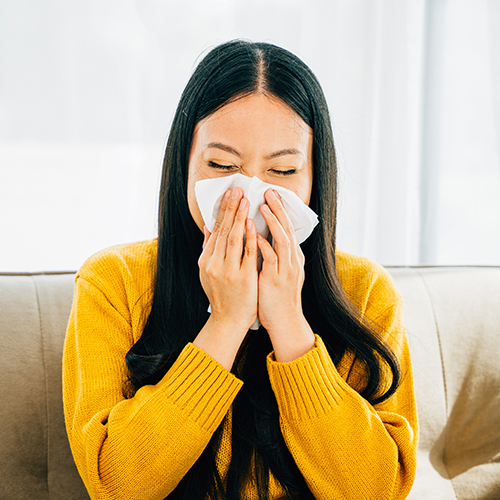August 2023
Allergies and asthma are common children’s health issues that often go hand-in-hand. In fact, 70%–80% school-aged kids with asthma have allergies, and allergies are one of the most common triggers for asthma.
Although asthma and allergies are separate conditions, understanding how they are related can help families better manage both conditions — and help their children lead healthier, more active lives. Here is what families need to know.
What are allergies?
Allergies occur when a person’s immune system overreacts to something harmless, such as pollen, pet dander, or dust. This overreaction can cause respiratory symptoms such as sneezing, itching, runny nose, and watery eyes.
Other types of allergies, such as certain food allergies and allergies to insect venom (such as bee stings), can trigger anaphylaxis. Symptoms include hives, a weak pulse, and trouble breathing. Left untreated, this can be life-threatening.
What is asthma?
Asthma is a lung condition that affects a person’s airways. It can cause the airways to become swollen and narrow and to produce excess mucus. This can cause difficulty in breathing (called an asthma attack). Symptoms include coughing, wheezing, shortness of breath, and chest tightness.
Like with allergies, asthma is caused by an overactive immune system reacting to something harmless. Common triggers for asthma in kids include the following:
- Allergens (such as dust, pet dander, pollen, and mold).
- Respiratory infections (such as the common cold and the flu).
- Exercise.
- Pollution (including smog and particulates).
- Cold, dry air.
What is the connection between allergies and asthma?
Both conditions involve an overactive immune system response. When a child with allergies is exposed to an allergen, their immune system releases chemicals called histamines. Histamines are responsible for the itchy and watery eyes, runny nose, and congestion typical with seasonal allergies. They can also cause inflammation.
For some children, this inflammation can affect the airways, leading to asthma symptoms. This is known as allergic asthma, which is the most common type of asthma in children.
How to manage allergies and asthma?
If allergies are a common trigger for your child’s asthma, a key part of preventing asthma attacks is identifying — and avoiding — any common triggers. Common allergens that can also trigger asthma include pollen, mold, pet dander, and dust mites. By reducing exposure to these allergens, you can help minimize your child’s symptoms.
General tips for reducing exposure to allergens
Some general tips for reducing allergen exposure include the following:
- Use HEPA filters at home. This will help remove allergens from the air.
- Wash sheets and blankets weekly, in hot water, and run them through the dryer until fully dry. This will help remove allergens from bedding, and the heat will help kill dust mites, a common source of allergens.
- Vacuum regularly with a HEPA vacuum cleaner. Vacuuming regularly removes allergens from the floor, where they can be kicked back up into the air. The HEPA filter will help keep the act of vacuuming from sending allergens airborne.
- If you have forced hot air or central air conditioning, be sure to regularly replace the filter on your HVAC system.
Pet allergies
Some children have serious enough pet allergies that a family will need to remove the pets from the home. But before you take such drastic measures, try the general measures listed above in addition to the following:
- Keep pets out of bedrooms.
- Bathe pets regularly. This will help remove dander (an allergen) and any pollen they pick up outside (another allergen).
Seasonal allergies
If your child suffers from seasonal allergies, you can take extra steps to protect them during the times they have problems.
- Have your child shower after being outside when pollen counts are high. If this is not possible, at least have them shower before bedtime. This will keep them from being exposed to pollen all night and contaminating their bedding.
- Close windows during high-pollen times of the day.
You can learn more about how to minimize spring allergies here and here. And these two articles can help you minimize fall allergies and avoid less commonly known fall allergy triggers.
Medical treatment for allergies
Ask your pharmacist or pediatrician if any over-the-counter medications (such as antihistamines and decongestants) can help manage your child’s allergy symptoms. This might also help reduce the risk of asthma attacks.
If your child’s allergies are interfering with their ability to have a normal, healthy life, ask your pediatrician about seeing an allergist for testing and treatment. Testing can help you hone in on the allergens you need to spend effort avoiding, and allergy shots can help reduce your child’s immune system’s reaction to allergens over time.
If your child has asthma, it is critical that you and your child’s pediatrician work together to create an asthma action plan to deal with any issues that do arise. This typically includes a combination of daily medications to reduce the frequency and severity of breathing problems and rescue medications to deal with asthma attacks in the moment.


